High-tech scanning around the ancient Maya city of Tikal in northern Guatemala has revealed the presence of some previously undiscovered ruins, dating back to the early first millennium AD. Using light detection and ranging technology (LiDAR), researchers spotted buried buildings that looked like precise replicas of structures found in the legendary Mesoamerican city of Teotihuacan, which reached the height of its power at the same time as the Maya Civilization was flourishing. This was surprising, since Teotihuacan was located 800 miles (1,300 kilometers) northwest of Tikal in modern-day Mexico and was not a Maya settlement.
Tikal’s Teotihuacan ‘Replicas’ Found After 60 Years of Digs
The spectacular ruins at Tikal have been heavily explored by archaeologists for more than six decades. Yet even now this fertile site is capable of producing new revelations, especially when modern technology can be used to scrutinize areas that haven’t been closely looked at in the past.
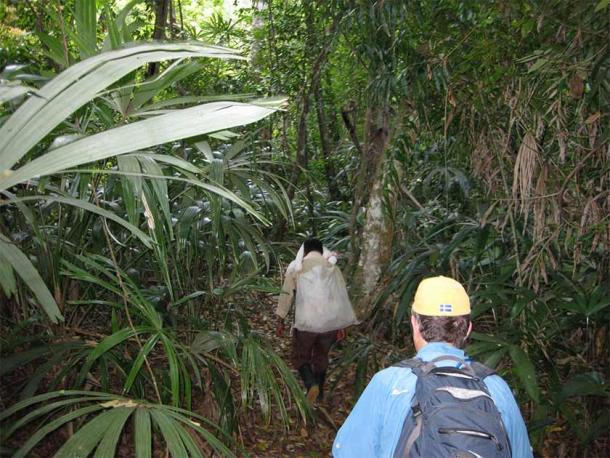
Archaeologists exploring the site’s surrounding area looking for the Teotihuacan replicas that were discovered by LiDAR scanning at the center of Maya Tikal in Guatemala. (C. Houston / Antiquity Publications Ltd )
In this instance, a pair of U.S.-based researchers affiliated with the Foundation for Maya Cultural and Natural Heritage (Pacunam), Brown University anthropologist Stephen Houston and University of Texas geographer Thomas Garrison, used LiDAR to map the contours of a set of hills found near the Tikal city center. As they explain in a new research study in the journal Antiquity, their measurements showed that these hills were actually man-made mounds and that buildings of a highly unusual nature were buried beneath them.
Follow-up excavations by Guatemalan archaeologists, under the leadership of University of Texas professor Edwin Román Ramírez, confirmed the existence of the buried structures. Unexpectedly, the buildings had been modeled after important structures in Teotihuacan, the most populated and powerful city-state in Mesoamerica in the first millennium AD.
“What we had taken to be natural hills actually were shown to be modified and conformed to the shape of the citadel — the area that was possibly the imperial palace — at Teotihuacan,” Dr. Houston explained in an Antiquity press release. “Regardless of who built this smaller-scale replica and why, it shows without a doubt that there was a different level of interaction between Tikal and Teotihuacan than previously believed.”
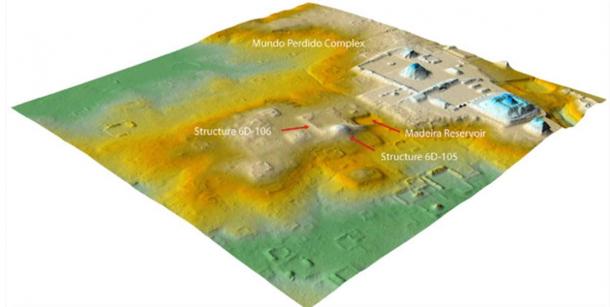
LIDAR view of the Tikal city center. The 6D-105 and 6D-106 sites are where the Teotihuacan replicas were later unearthed by the team of archaeologists. (T. Garrison/PACUNAM / Antiquity Publications Ltd )
Tikal and Teotihuacan: Were they Friends or Enemies?
The great city-state of Teotihuacan , home of the Americas’ most spectacular pyramids , was the most populated city in Mesoamerica, with more than 125,000 inhabitants at its peak of power. Even now, we don’t exactly know who the Teotihuacans were.
No Maya city was as populated as Teotihuacan. The latest studies show that the Maya world was home to more than 11 million people during the Classical Era (250 AD to 900 AD).
It isn’t known who founded Teotihuacan, although evidence suggests it was a cosmopolitan city occupied by a diverse population comprised of different ethnic groups. Like the Maya Civilization , Teotihuacan reached the height of its power and influence during the first half of the first millennium AD. Teotihuacan established trading relationships with Maya settlements to the south and east, and people from Teotihuacan and Tikal frequently visited each other’s cities for business and cultural exchange.
But the newest discoveries at Tikal show that people from Teotihuacan had a stronger presence in the city than previously believed. The individuals who built the newly excavated Teotihuacan replicas were apparently not interested in assimilating into the culture they’d entered, but instead preferred to create their own “home-away-from home” on Maya soil.
“The architectural complex we found very much appears to have been built for people from Teotihuacan or those under their control,” Dr. Houston said. “Perhaps it was something like an embassy complex, but when we combine previous research with our latest findings, it suggests something more heavy-handed, like occupation or surveillance. At the very least, it shows an attempt to implant part of a foreign city plan on Tikal.”
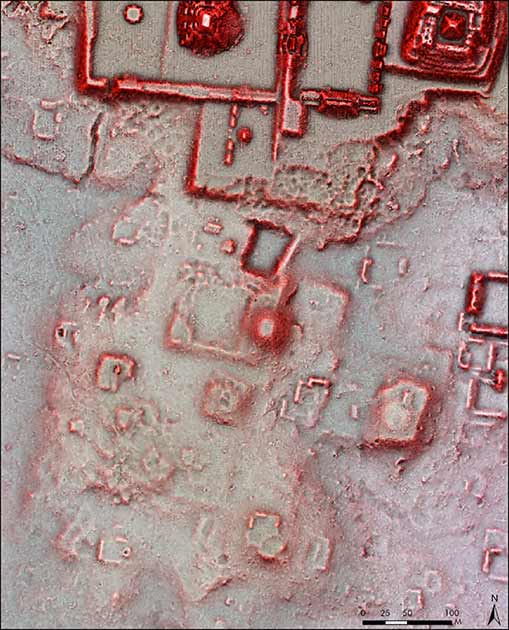
Filtered lidar highlighting the structures and quarrying at Tikal in the area where the Teotihuacan replicas were discovered. (T. Garrison / PACUNAM / Antiquity Publications Ltd )
Many of the structures in the Teotihuacan replica enclave were built from mud plaster rather than traditional Maya limestone. They included complete and accurate recreations of the buildings that comprised the Teotihuacan citadel complex, featuring angular measurements and directional orientations that matched the characteristics of the citadel exactly.
“It almost suggests that local builders were told to use an entirely non-local building technology while constructing this sprawling new building complex,” Houston said. “We’ve rarely seen evidence of anything but two-way interaction between the two civilizations, but here, we seem to be looking at foreigners who are moving aggressively into the area.”
During the excavations, the archaeologists uncovered chilling signs of possible human sacrifice. Near the citadel replica, the archaeologists dug up the remains of a body. The skeleton was surrounded by ceramic vessels, animal bones, projectile points, and other items of a personal nature. Charcoal found at the site shows the grave and its contents had been set on fire. All of this matches what has been found at burial sites located near the real citadel in Teotihuacan, which held the remains of warriors who were sacrificed to the gods.

Teotihuacan-style incense burner fragments from the front platform of one of the Teotihuacan replicas at Tikal (Structure 6D-105; see LIDAR map above). (E. Román / PACUNAM / Antiquity Publications Ltd )
Another significant discovery strongly suggests that the Teotihuacan immigrants and their native Maya neighbors didn’t always get along. At a residential complex located next to the citadel complex, the archaeologists found a mixed collection of weapon projectile points, which included some made from flint (used by the Maya) and some from green obsidian (commonly used in Teotihuacan). At least one battle between indigenous residents and immigrants may have taken place at this site, although when it occurred and how much bloodshed occurred cannot be determined.
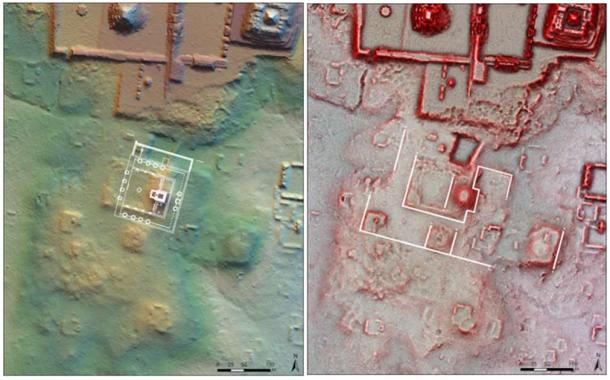
Left: Overlay (at 30 per cent size) of the Teotihuacan Ciudadela in the Tikal precinct, showing the same orientation, flanking platforms, eastern pyramid, western enclosure and north–south corridor of the original Teotihuacan citadel complex at the western entrance to the precinct (figure by T. Garrison/PACUNAM). Right: Alignments in the “Ciudadela” precinct at Tikal, overlayed with the orientation of Teotihuacan (15°28′00). (figure by T. Garrison / PACUNAM / Antiquity Publications Ltd )
The Fall of Tikal: What Really Happened?
In 378 AD, military forces from the city of Teotihuacan invaded Tikal and overthrew its Maya king. The soldiers from Teotihuacan were led by a general known as Sihyaj K’ahk’, which translated means “Born from Fire.” These invaders were apparently not dispatched by the rulers of Teotihuacan, but instead carried out the invasion on their own, after being exiled from their home city for reasons that remain unknown.
Previously, this action had seemed rather random. But if people from Teotihuacan were already living in Tikal by 378 AD, Born From Fire’s marauders may have had inside information about the city’s defenses and may have received direct assistance and support from people who welcomed their arrival.
They may have even used the presence of people from Teotihuacan in Tikal as an excuse to justify their invasion. They may have claimed that the Teotihuacan minority was being persecuted, and that seizing control of the Maya city was the only way they could protect their people from abuse.
This has been a common strategy used by conquerors throughout human history. For example, when Adolf Hitler occupied Czechoslovakia and Austria in the 1930s, he said he did so because German minorities living in those territories were in danger. The United States government claimed much the same thing in the mid-19th century, when they used alleged atrocities committed by Mexico against American citizens as an excuse to launch the Mexican-American War (Mexico was forced to cede 40 percent of its territory to the U.S. after the war was over). In more recent times, Russia justified its annexation of the Crimea from the Ukraine by claiming that ethnic Russian citizens living there needed the mother country’s protection.
The same type of rationale may have been used by the invaders from Teotihuacan, to justify their seizure of Tikal. This is speculative, but it would certainly fit a familiar historical pattern.
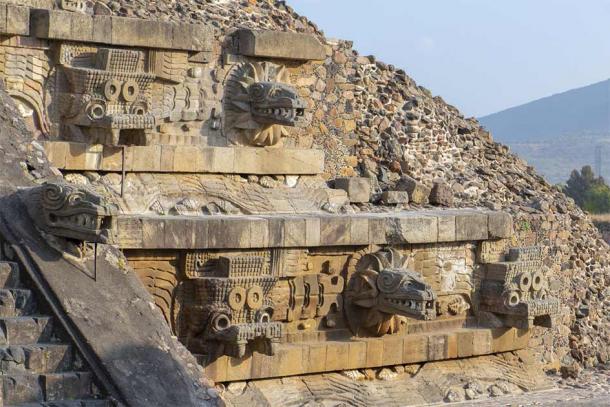
The temple of Quetzalcoatl at the citadel in Teotihuacan, Mexico. In the next years we will be sure to see as much detail in the newly discovered Teotihuacan replicas of Tikal, and also learn more about the relations between these two great cultures. ( jiawangkun / Adobe Stock)
Teotihuacan and the History of Colonization in the Americas
Excavations at the newly discovered site in Tikal will resume this fall. The archaeologists hope to uncover more artifacts, structures, and possibly written texts that will shed more light on how Teotihuacan and its people interacted with their smaller and less powerful neighbors in the early part of the first millennium AD. From such data, the archaeologists hope to learn more about the dynamics of colonialism in general.
“Before European colonization of the Americas, there were empires and kingdoms of disproportionate influence and strength interacting with smaller civilizations in a way that left a large impact,” Dr. Houston said. “Exploring Teotihuacan’s influence on Mesoamerica could be a way to explore the beginnings of colonialism and its oppressions and local collusions.”
Top image: A view of the Tikal jungle landscape from Temple IV. It was in this dense forested area that LIDAR amazing found the Teotihuacan replicas hidden from archaeologists working at the famous site for more than 60 years. Source: JuanLuis / Adobe Stock
By Nathan Falde
 RSS Feed
RSS Feed















 September 29th, 2021
September 29th, 2021  Awake Goy
Awake Goy  Posted in
Posted in  Tags:
Tags: 













